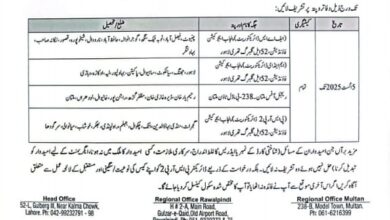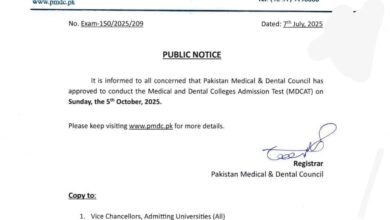Punjab Education Minister’s Big Announcement on Headmaster Appointment

The Punjab Education Minister, Rana Sikandar Hayat, has made a significant announcement regarding the appointment of Headmasters in government schools across the province. This decision, while welcomed by some, has brought disappointment to others within the education sector.
Contents
- 1 Punjab Education Minister’s Big Announcement on Headmaster Appointment!
- 2 Key Implications of the New Policy
- 3 Frequently Asked Questions (FAQs)
- 3.1 Q1: Why are AEOs who passed the test not being appointed as Headmasters?
- 3.2 Q2: What is the good news for IT Teachers and SSEs?
- 3.3 Q3: How many schools will get new Headmasters?
- 3.4 Q4: Will there be any additional benefits for the newly appointed Headmasters?
- 3.5 Q5: Where can I find more official updates on these appointments?
- 4 Conclusion
Punjab Education Minister’s Big Announcement on Headmaster Appointment!
Punjab Education Minister Rana Sikandar Hayat recently announced plans to appoint permanent Headmasters in 35,000 government schools across the province. This move aims to address long-standing vacancies and improve the overall quality of education and administrative control in these institutions. The minister emphasized that this step is crucial for strengthening school management and enhancing academic performance. Additionally, appointed Headmasters will receive an extra monthly compensation of Rs 10,000 as an incentive for these critical leadership roles.
🔴 Bad News for AEOs: A Setback for Aspiring Headmasters
Despite having passed the Headmaster test and cleared subsequent interviews, Assistant Education Officers (AEOs) in Punjab will not be appointed as Headmasters. This decision comes as a significant blow to AEOs who had diligently pursued these positions.
- AEOs’ Role and Responsibilities: Assistant Education Officers (AEOs) play a crucial role in the Punjab education system. They are responsible for supervising 15-22 schools within their markaz (cluster of schools), ensuring quality education, improving school functionality, implementing School Education Department (SED) initiatives, maintaining administrative records, and mobilizing the community for school improvement. Their extensive experience in school oversight might have led many to believe they were ideal candidates for Headmaster roles.
🟢 Good News for IT Teachers & SSEs: A New Opportunity
In contrast, the announcement brings positive news for IT Teachers and SSEs (Subject Specialist Educators). Candidates from these categories who have successfully passed the Headmaster test and cleared the interview will be appointed as Headmasters. This opens up new avenues for these educators to take on leadership roles within the school system.
- IT Teachers: With the increasing emphasis on digital literacy and technology integration in education, IT Teachers bring valuable skills to school administration. Their expertise can be instrumental in modernizing school operations and fostering a tech-savvy learning environment.
- SSEs (Subject Specialist Educators): SSEs possess in-depth knowledge in their respective subjects, which can be beneficial in enhancing the academic quality of schools. Their appointment as Headmasters can lead to improved pedagogical practices and better student outcomes.
Why This Decision?
While the exact rationale for excluding AEOs from Headmaster appointments hasn’t been explicitly detailed in recent public statements, it could be part of a broader strategy to diversify school leadership and bring in fresh perspectives. The government’s focus on appointing permanent Headmasters reflects a commitment to stable leadership and improved governance in schools, aiming to enhance the overall educational landscape in Punjab.
Key Implications of the New Policy
This new policy has several implications for the Punjab education sector:
- Morale of AEOs: The decision is undoubtedly disappointing for AEOs who have invested time and effort in preparing for and passing the Headmaster selection process.
- Opportunities for IT Teachers and SSEs: This policy creates significant career advancement opportunities for IT Teachers and SSEs, recognizing their valuable contributions and potential in leadership roles.
- Focus on Specialization: The preference for IT Teachers and SSEs might indicate a shift towards specialized leadership in schools, where individuals with distinct skill sets are placed in administrative positions.
- Impact on School Management: The appointment of new Headmasters is expected to streamline administrative control and improve academic standards across the 35,000 government schools.
Frequently Asked Questions (FAQs)
Q1: Why are AEOs who passed the test not being appointed as Headmasters?
A1: While the precise reasons are not fully public, the decision by the Punjab Education Minister, Rana Sikandar Hayat, indicates a policy shift prioritizing other categories like IT Teachers and SSEs for Headmaster appointments, despite AEOs clearing the selection criteria.
Q2: What is the good news for IT Teachers and SSEs?
A2: IT Teachers and SSEs who have successfully passed the Headmaster test and interview will be appointed as Headmasters, offering them a significant career progression opportunity.
Q3: How many schools will get new Headmasters?
A3: The Punjab government plans to appoint permanent Headmasters in 35,000 government schools across the province.
Q4: Will there be any additional benefits for the newly appointed Headmasters?
A4: Yes, newly appointed Headmasters will receive an additional monthly compensation of Rs 10,000.
Q5: Where can I find more official updates on these appointments?
A5: Official notifications and updates are typically released by the School Education Department, Government of Punjab, and can be found on their official website (https://schools.punjab.gov.pk/notifications). You can also stay updated through reliable news portals like umernews.com.
Conclusion
The Punjab Education Minister’s latest announcement marks a pivotal moment in the province’s educational landscape. While it serves as a demotivating factor for Assistant Education Officers, it simultaneously empowers IT Teachers and Subject Specialist Educators with new leadership prospects. This strategic move aims to infuse fresh perspectives and specialized expertise into school administration, ultimately working towards the overarching goal of enhancing the quality of education in Punjab. As these appointments roll out, the education community will be keenly observing the impact of these changes on school governance and academic outcomes.
Site Name: umernews.com
Punjab Headmaster Jobs 2025 – Eligibility, Age Limit, Qualification & Selection Process
This video details the eligibility criteria and selection process for Headmaster jobs in Punjab, which is directly relevant to the announcement.
📢 ہیڈ ماسٹر اپوائنٹمنٹ پر وزیر تعلیم کا بڑا اعلان!
🔴 بری خبر برائے AEOs:
وزیر تعلیم پنجاب رانا سکندر حیات نے واضح طور پر اعلان کر دیا ہے کہ
✅ جن AEOs نے ہیڈ ماسٹر ٹیسٹ پاس کیا
✅ اور انٹرویو بھی کلیئر کیا
❌ انہیں ہیڈ ماسٹر اپوائنٹ نہیں کیا جائے گا۔
🟢 اچھی خبر برائے IT Teachers & SSEs:
وہ امیدوار جن کا تعلق آئی ٹی ٹیچرز یا SSEs کیٹیگری سے ہے،
✅ اور جنہوں نے ٹیسٹ و انٹرویو کامیابی سے پاس کیا ہے
🎉 وہ ہیڈ ماسٹر کے عہدے پر اپوائنٹ کیے جائیں گے۔
؟📌 AEOs کے لیے یہ فیصلہ انتہائی مایوس کن ہے، جبکہ باقی کیٹیگریز کے لیے خوش آئند۔








